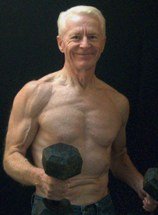| Back to Back Issues Page |
 |
|
The Gray Iron Fitness Newsletter, Issue #97, Don't Hold Your Breath. September 01, 2012 |
Hi
September 1, 2012
In this newsletter . . . Don't Hold Your BreathAre you a shallow breather? Look down at your belly for a moment. Does it rise as you inhale? If not, you are shallow breathing. In Yoga, the martial arts, or any meditation or relaxation training, students are taught to focus on relaxed deep breathing as a means of calming the mind and body, which in turn lowers blood pressure and slows heart rates. When I taught classes at a health club, I found the relaxation and gentle stretching that followed resistance and cardio training was the least popular phase of the workout. A few people would even duck out of the room. I wished it weren’t so. I would explain that they were shortchanging themselves by not devoting a little time to relaxing mind and body after working out. Some listened but others always seemed in too much of a rush to be bothered. People do have busy lives, but that’s exactly why slowing down for a few moments can be so valuable to their well-being. An even more serious matter regarding breathing is the practice of what is known as the “Valsalva maneuver.” Even many long time fitness buffs may not know what the term means, but unknowingly practice it or something like it. You’ve probably seen the following many times in the gym: A guy is doing a heavy bench press; he’s holding his breath and red in the face, looking like his head is about to explode, in an almost do or die struggle to get that last wonderful rep. He may not know the term for it, but he is practicing the Valsalva maneuver. When you lift or push something heavy there is a natural tendency to hold your breath. Some coaches even teach it as a way of increasing intra-abdominal pressure, thereby providing more back support. But it can have dangerous consequences - especially for seniors. Blood pressure skyrockets when chest cavity pressure increases as you hold your breath. Dizziness or fainting can result, and even a stroke, cerebral hemorrhage, or retinal detachment are possibilities. Some lifters will say the dangers of Valsalva are exaggerated. And I’m sure there are younger lifters who use it to their advantage and get away with it. But my advice is don’t do it. Breathe! Ed Yarick was my first trainer and showed me the basics. He would say to beginners: Do not hold your breath. Exhale as you push the weight away from you. Inhale as you return the weight. I developed a rhythmic breathing pattern that I practice to this day. You didn’t ignore the man who showed Steve Reeves the ropes. Most trainers today tell their clients not to hold their breath, which is good. But most don’t make as much of an issue about exhaling during the pushing phase of a lift. They just say, “Don’t hold your breath. Breathe.” And that’s certainly a plus. But Ed Yarick’s instruction to emphasize exhaling during the exertion part of a push was even better. So don’t hold your breath. Breathe the Ed Yarick way. And also take a little quiet time daily to practice deep belly breathing to relax your mind and body. It's a habit you won't regret.

You've probably heard about the tremendous benefits of weight training and how you can retain -- or even reclaim -- the attributes of youth . . . Discover the way with . . . Gray Iron: A Fitness Guide for Senior Men and Women
 Newsletter Policy The Gray Iron Fitness Newsletter is a free publication sent twice monthly to subscribers. The purpose is to provide honest and realistic fitness information for people age 50 and above. I have never been paid or received compensation of any kind to write a positive review or endorse a product. If I say that I personally use a product or service, it is because I find value in it and have paid for it with my own money. Like newspapers, magazines and television, this newsletter and my web site contain advertising and marketing links. Naturally, I am compensated for these. The newsletter and web site provide information to help users establish and maintain a fitness lifestyle. But fitness information is not the same as fitness advice, which is the application of exercise and dietary practices to an individual's specific circumstances. Therefore, always consult with your physician for assurance that fitness information, and your interpretation of it, is appropriate for you. Your comments and questions are always appreciated. Simply click on the "Reply" bottom. |
| Back to Back Issues Page |